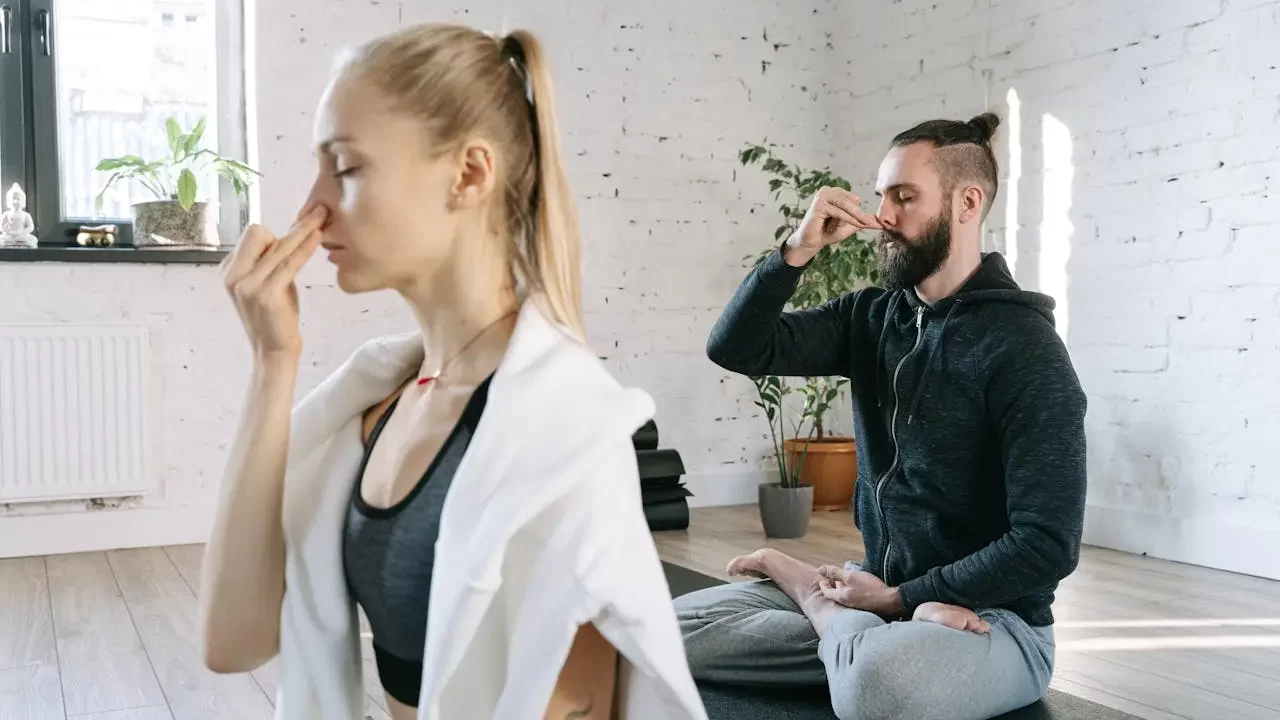
You breathe all day, whether slow and steady, when you excel in exercise or even when your stress levels are heightened. But how can you use breathwork to control and focus? It is now a powerful tool used to enhance your health and wellness. Breathwork has so many benefits, from anxiety and stress relief to improving sports performance; there is something for everyone.
Let’s discover how the benefits of breathwork can enrich your health with some key tips and techniques for optimal well-being.
Understanding of breathwork, more than just breathing
Breathwork is more than just taking a deep breath in and out. It’s a deliberate practice, often rooted in ancient traditions like yoga and meditation, that uses different breathing techniques to achieve specific outcomes. Breathwork can involve varying the speed, depth, and rhythm of breathing, and it can be practiced alone or in groups, sometimes accompanied by guided visualizations or movement.
The practice is gaining popularity not just among wellness enthusiasts but also in the fields of sports, mental health, and rehabilitation. The reason is simple: breathwork has been shown to impact nearly every system in the body. From the cardiovascular and respiratory systems to the nervous and endocrine systems, controlled breathing can bring about a host of physiological changes that promote health and well-being.
Breathwork is a practice performed deliberately. It is traditionally used in yoga, known as pranayama, meditation which helps to achieve different outcomes, this depends on the variation of speed, depth, and rhythm and can also be performed alone or in a group setting. Many groups have guides who can lead the journey of the breathwork.
Breathwork is becoming very popular among wellness leaders and in various sports and mental health practices. According to Nidhi Saha’’s article, ‘Current evidence proposes that one session of slow-paced deep breathing benefits the vagal tone (measured through HRV) and attenuates anxiety in adults’.
Breathwork benefits anxiety, providing relief. It also benefits the entire body and promotes health and well-being through various physiological changes in the nervous and endocrine systems.
Breathwork Techniques: A Closer Look
There are so many different breathwork techniques used; here are just some of them and their benefits:
- Diaphragmatic breathing (also known as belly breathing)
This is a more simple technique. According to Michigan Medicine ‘The breath is taken the stomach, rather than the chest, moves with each breath, expanding while inhaling and contracting while exhaling’. This technique encourages maximum oxygen exchange, which releases Carbon dioxide in exchange for taking in oxygen. This enables the body to go into a full state of relaxation.
- Box breathing
Navy SEALS and athletes and professionals with a high-stress workload often use it. Inhale, hold your breath, then exhale, doing each of these for the count of four. This has been known to enhance focus and performance, reduce stress by lowering cortisol levels, balance emotional levels, and improve physical recovery. It also improves lung capacity, which is great for swimmers. An article written by Ana Gotter states that ‘Box breathing can reduce stress and improve your mood. That makes it an exceptional treatment for conditions such as generalized anxiety disorder (GAD), panic disorder, post-traumatic stress disorder (PTSD), and depression.’
- Wim Hof Method
The Wim Hof breathwork benefits are substantial. Combining deep inhalations in breathwork with cold water therapy practices. The breathwork involves a cycle of deep breathing followed by short periods of breath-holding. This technique is well known for its studies on boosting the immune system, which helps fight those bugs more effectively. It is widely used among athletes to improve stamina and endurance and speed up recovery times from training. As well as these studies, this technique has been linked to lower levels of inflammation, crucial to preventing chronic disease.
The first pillar of the Wim Hof Method is breathing, something we all do but often underestimate. By increasing oxygen levels through a unique breathing technique, you can unlock the powerful benefits of Wim Hof Method like having more energy, lower stress, and a stronger immune system that helps fight off illness.
The cold, one of the three pillars of the Wim Hof Method, is like a helpful friend. By exposing yourself to cold, you can trigger a range of health benefits: increased fat burning, reduced inflammation, a stronger immune system, balanced hormones, better sleep, and a boost in mood thanks to the release of feel-good endorphins.
The Wim Hof Method’s third pillar is focus and dedication. To truly master cold exposure and breathing, you need patience and commitment. With these, you can unlock the full potential of your body and mind. Click here to find out more about the Wim Hof Method.
- Alternate nostril breathing (Nadi Shodhana)
Originating from Yoga, this technique uses inhalation through one nostril whilst the other is closed and then repeats switching sides. It has been known to balance the left and right sides of the brain, which harmonizes the autonomic nervous system. It can clear the nasal passages, enabling more oxygen to freely enter the body, thus giving more mental clarity and alertness to perform cognitive tasks. In Rolf Sodik’s recent article, ‘this practice calms, purifies, and strengthens the nervous system and deepens self-awareness—excellent preparation for meditation.’ The benefits of breathwork for anxiety are vast and should be exercised for those who suffer from anxiety, whether it is minor or chronic.
Benefits of Breathwork
Breathwork to help with stress reduction
We have all heard about the ‘fight or flight’ response; this is when our sympathetic nervous system goes into overdrive, our heart rate increases, blood pressure rises, and our stress hormone levels skyrocket, preparing the body to react. If the body is overloaded with this response, it becomes worn down. Breathwork can help regulate the nervous system by activating the parasympathetic nervous system, promoting relaxation and recovery in the body. Regular practices of this can help to reduce stress hormone baseline levels such as cortisol and promote long-term health benefits.
Benefits of breathwork for anxiety and sleep quality
Stress often disrupts sleep, leading to a vicious cycle of poor rest and increased anxiety. Breathwork can help break this cycle by promoting relaxation before bed. Techniques such as slow, deep breathing or box breathing can be incorporated into a bedtime routine to calm the mind and body, making it easier to fall asleep and stay asleep. 4-7-8 breathing is another good breathing technique to help with sleep.
Breathwork and Chronic Pain Management
Chronic pain affects millions of people worldwide and is often resistant to conventional treatments. Breathwork offers an alternative or complementary approach to pain management. According to the London Pain Clinic, ‘Diaphragmatic breathing is an essential component of relaxation training and is often recognized as a part of the bio-behavioural pain control. When used for the treatment of chronic pain, this also involves the development of proper breathing techniques in coordination with body movement to avoid muscular guarding and the resulting referred pain.’
Pain Perception and Breathwork
Breathwork influences the way the brain processes pain signals. By focusing on the breath, individuals can shift their attention away from the pain, reducing the brain’s perception of it. Techniques such as diaphragmatic breathing can also promote relaxation, which helps ease muscle tension and reduce pain.
Moreover, the stress reduction benefits of breathwork can be particularly valuable for chronic pain sufferers, as stress often exacerbates pain symptoms. By managing stress through breathwork, individuals can experience less pain and improve their quality of life.
Incorporating Breathwork into Daily Life
Integrating breathwork into your daily routine requires little time or special equipment. Here are some practical tips for making breathwork a regular part of your life:
1. Start Small: Start with five minutes of focused breathing daily. You can gradually increase the time as you become more comfortable with the practice.
2. Find a Quiet Space: While breathwork can be done anywhere, finding a quiet, comfortable space can help you focus and maximize your practice.
3. Use Technology: Many apps and online resources offer guided breathwork sessions, which can be particularly helpful for beginners.
4. Incorporate Breathwork into Existing Routines: Try adding breathwork to your morning routine, during breaks at work, or as part of your bedtime ritual.
5. Be Patient: Like any new habit, breathwork takes time to master. Be patient with yourself and enjoy the process of learning to connect more deeply with your breath.
Using Breathwork to Build a Lifelong Practice
Breathwork is a simple, accessible practice with profound effects on physical wellness. Firstly, it creates conscious habits. Naturally, we seek pleasure, but this can cause us to develop bad habits. Let’s take the nervous system. This seeks anything that makes us feel good, giving a quick dose of our ‘feel good’ chemical called dopamine. Generally speaking, when the result of a habit is satisfying, this is not stored by an area where the conscious brain controls this; this is why these habits can be so challenging to kick. When the bad habits are formed, they are done so by a habit loop; here is an example of a habit loop;
Let’s use the example of being a social drinker.
- The cue is your trigger. The thing that causes the habit loop to kick off. In this instance, the cue is having friends around to watch the sports game, maybe something you’ve all been doing for many years, associating that feeling of adrenaline with having that can of beer in your hand.
- The craving kicks in. You desire to receive that feeling of satisfaction you’ve felt before, so you are moved to act.
- The act is the action, and so you open that can of bee, the sound of the ring pull, the loud hiss of the pressure of the open beer.
- The reward is the first sip of the beer. Once you get the first one down, you’re on to the next one. The feeling of more confidence, euphoria, and relaxation all start to kick in.
Knowing your bad habits can help you form good habits loops; for example, practice some of the breathwork exercises above to help relieve stress levels, help you sleep, and even build your self-confidence.
Taking control of your breath can enhance athletic performance, reduce stress, manage pain, and improve overall health. The beauty of breathwork lies in its simplicity—it’s a tool that’s always with you, ready to be used whenever you need it, whether you’re an athlete looking to push your limits. It can help to be present, this way you can focus on the slowing of your breath, noticing what is happening around you as well as inside your body and mind. Be aware of any feelings of negativity you have or pain you have been suffering, or maybe it’s feelings you have been holding on to for too long and want to start letting go. Just try and stay with your breath and wait until you begin to feel your attention go to your breath in the present.
Developing a daily breath awareness practice is so beneficial on many levels. The more you practice it, the more it becomes second nature. You’ll start to notice your actions more clearly, and you’ll be able to stop those negative behaviors before you indulge in them.
References
- Saha, Nidhi. “News-Medical.” News-Medical, 13 Jan. 2023, www.news-medical.net/news/20230113/Review-and-meta-analysis-suggests-breathwork-may-be-effective-for-improving-stress-and-mental-health.aspx#:~:text=Current%20evidence%20proposes%20that%20one. Accessed 6 Sept. 2024.
- “Diaphragmatic Breathing for GI Patients | Michigan Medicine.” Www.uofmhealth.org, www.uofmhealth.org/conditions-treatments/digestive-and-liver-health/diaphragmatic-breathing-gi-patients#:~:text=When%20practicing%20diaphragmatic%20breathing%2C%20the.
- Gotter, Ana . “Box Breathing.” Healthline, 23 Mar. 2017, www.healthline.com/health/box-breathing#benefits.
- “Joyous Mind: The Practice of Nadi Shodhanam (Alternate Nostril Breathing).” Yogainternational.com, yogainternational.com/article/view/joyous-mind/. Accessed 27 Oct. 2023.
- “Breathing Techniques for Sleep.” WebMD, www.webmd.com/sleep-disorders/breathing-techniques-sleep. Accessed 11 Oct. 2021.
- London Pain Clinic. “Diaphragmatic Breathing and Chronic Pain.” London Pain Clinic, 21 Nov. 2011, www.londonpainclinic.com/resources/diaphragmatic-breathing-and-chronic-pain/.



Leave a Reply